Leads4Pass az-305 dumps are valid exam materials for 2025
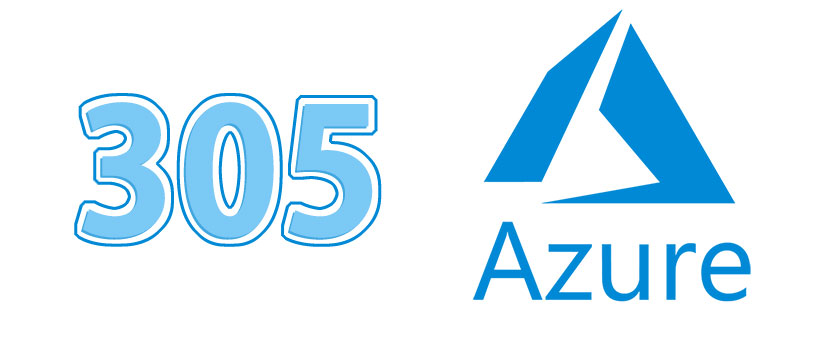
Leads4pass AZ-305 dumps contain 400 latest exam questions and answers in 2025. Each exam question is carefully designed to match the actual exam questions and answers. It is a really effective Designing Microsoft Azure Infrastructure Solutions certification exam material.
Download the AZ-305 dumps: https://www.leads4pass.com/az-305.html, use the VCE exercises, or read the PDF, which is all eligible for exam preparation.
Latest AZ-305 exam practice questions online share
| Number of exam questions | Exam name | Exam code | Related | Updated |
| 15 (Free) | Designing Microsoft Azure Infrastructure Solutions | AZ-305 | Microsoft Role-based | Oct 2025 |
Question 1:
You have an Azure subscription that contains an Azure SQL database.
You plan to use Azure reservations on the Azure SQL database.
To which resource type will the reservation discount be applied?
A. vCore compute
B. DTU compute
C. Storage
D. License
Correct Answer: A
Explanation:
Quantity: The amount of compute resources being purchased within the capacity reservation. The quantity is a number of vCores in the selected Azure region and Performance tier that are being reserved and will get the billing discount.
For example, if you run or plan to run multiple databases with the total compute capacity of Gen5 16 vCores in the East US region, then you would specify the quantity as 16 to maximize the benefit for all the databases.
Reference: https://docs.microsoft.com/en-us/azure/azure-sql/database/reserved-capacity-overview
Question 2:
HOTSPOT
You have an Azure subscription. The subscription contains 100 virtual machine that am Windows Server.
You need to recommend a solution that will provide monitoring and an audit trail of the following modifications:
1.
Changes to the Windows registry on the virtual machines
2.
Changes to the DNS settings of the virtual machines
The solution must minimize administrative effort.
What should you recommend using for each change? To answer, select the appropriate options in the answer area.
NOTE: Each correct selection is worth one point.
Hot Area:
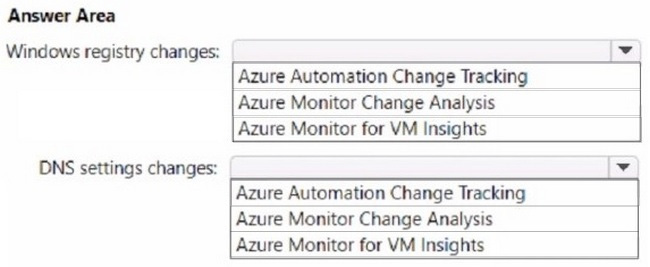
Correct Answer:
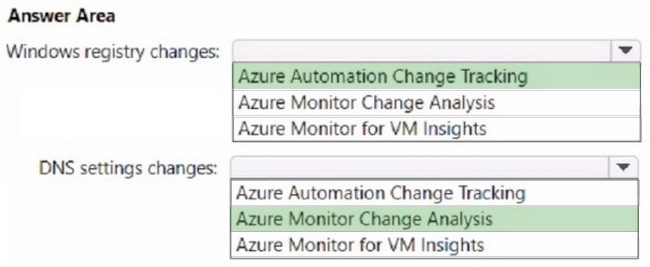
Question 3:
HOTSPOT
You are designing a cost-optimized solution that uses Azure Batch to run two types of jobs on Linux nodes. The first job type will consist of short-running tasks for a development environment. The second job type will consist of long-running
Message Passing Interface (MPI) applications for a production environment that requires timely job completion.
You need to recommend the pool type and node type for each job type. The solution must minimize compute charges and leverage Azure Hybrid Benefit whenever possible.
What should you recommend? To answer, select the appropriate options in the answer area.
NOTE: Each correct selection is worth one point.
Hot Area:
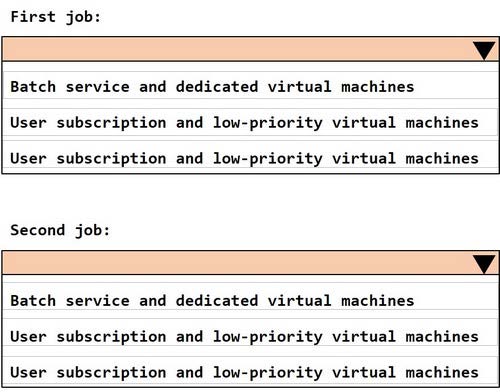
Correct Answer:
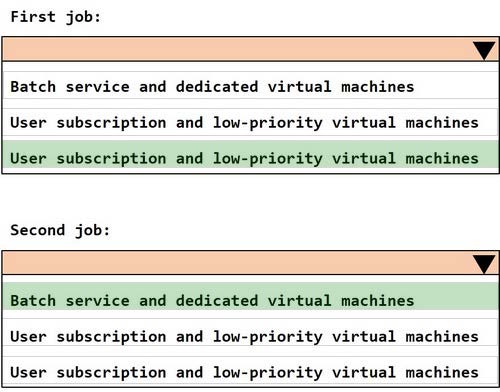
Question 4:
HOTSPOT
You plan to deploy a network-intensive application to several Azure virtual machines.
You need to recommend a solution that meets the following requirements:
Minimizes the use of the virtual machine processors to transfer data Minimizes network latency
Which virtual machine size and feature should you use? To answer, select the appropriate options in the answer area.
NOTE: Each correct selection is worth one point.
Hot Area:
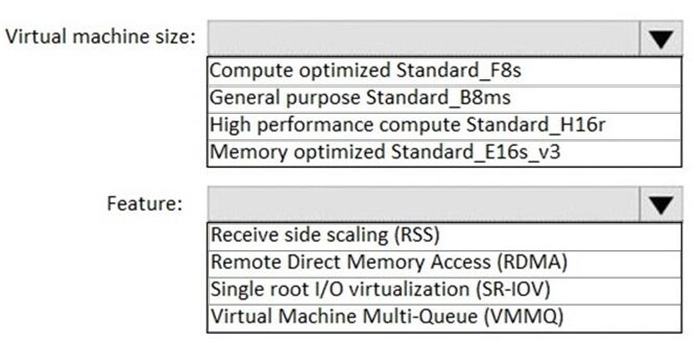
Correct Answer:
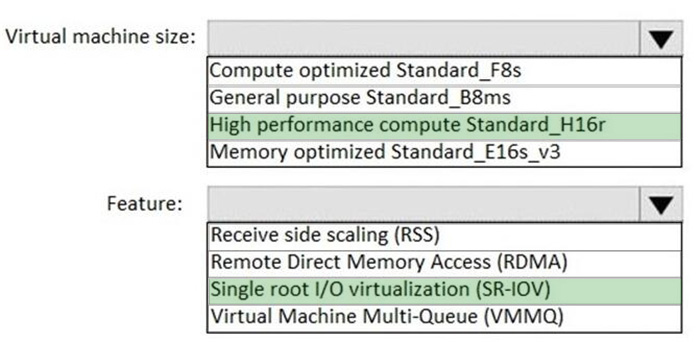
References: https://docs.microsoft.com/en-us/azure/virtual-machines/windows/sizes-hpc#h-series
Question 5:
Your company has 300 virtual machines hosted in a VMware environment. The virtual machines vary in size and have various utilization levels.
You plan to move all the virtual machines to Azure.
You need to recommend how many and what size Azure virtual machines will be required to move the current workloads to Azure. The solution must minimize administrative effort.
What should you use to make the recommendation?
A. Azure Cost Management
B. Azure Pricing calculator
C. Azure Migrate
D. Azure Advisor
Correct Answer: C
Explanation:
“Metadata discovered by the Azure Migrate appliance helps you to figure out whether servers are ready for migration to Azure, right-size servers, plans costs, and analyze application dependencies”.
https://docs.microsoft.com/en-us/learn/modules/design-your-migration-to-azure/2-plan-your-azure-migration https://docs.microsoft.com/en-us/azure/migrate/migrate-appliance#collected-data—vmware
Question 6:
HOTSPOT
You deploy several Azure SQL Database instances.
You plan to configure the Diagnostics settings on the databases as shown in the following exhibit.
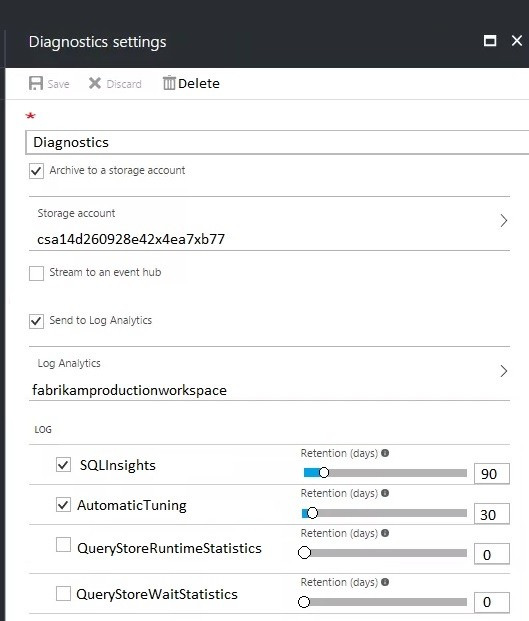
Use the drop-down menus to select the answer choice that completes each statement based on the information presented in the graphic. NOTE: Each correct selection is worth one point.
Hot Area:
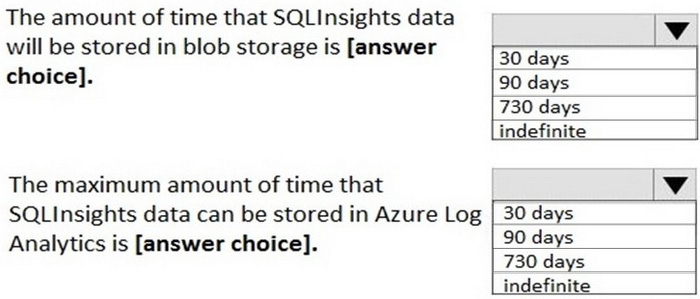
Correct Answer:
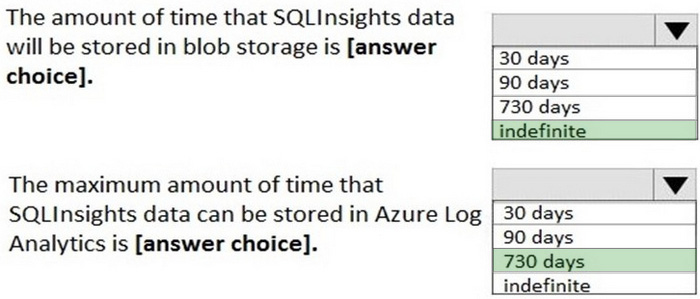
In the exhibit, the SQLInsights data is configured to be stored in Azure Log Analytics for 90 days. However, the question is asking for the “maximum” amount of time that the data can be stored which is 730 days.
Question 7:
A company deploys Azure Active Directory (Azure AD) Connect to synchronize identity information from their on-premises Active Directory Domain Services (AD DS) directory to their Azure AD tenant.
The identity information that is synchronized includes user accounts, credential hashes for authentication (password sync), and group memberships. The company plans to deploy several Windows and Linux virtual machines (VMs) to support their applications.
The VMs have the following requirements:
1.
Support domain join, LDAP read, LDAP bind, NTLM and Kerberos authentication, and Group Policy.
2.
Allow users to sign in to the domain using their corporate credentials and connect remotely to the VM by using Remote Desktop.
You need to support the VM deployment.
Which service should you use?
A. Active Directory Federation Services (AD FS)
B. Azure AD Privileged Identity Management
C. Azure Managed Identity
D. Azure AD Domain Services
Correct Answer: D
Explanation:
Azure AD Domain Services provides managed domain services such as domain join, group policy, LDAP, Kerberos/NTLM authentication that are fully compatible with Windows Server Active Directory.
Reference: https://docs.microsoft.com/en-us/azure/active-directory-domain-services/active-directory-ds-overview
Question 8:
You manage an on-premises network and Azure virtual networks.
You need to create a secure connection over a private network between the on-premises network and the Azure virtual networks. The connection must offer a redundant pair of cross connections to provide high availability.
What should you recommend?
A. Azure Load Balancer
B. VPN Gateway
C. ExpressRoute
D. virtual network peering
Correct Answer: B
Explanation:
Every Azure VPN gateway consists of two instances in an active-standby configuration. For any planned maintenance or unplanned disruption that happens to the active instance, the standby instance would take over (failover) automatically.
Reference: https://docs.microsoft.com/en-us/azure/vpn-gateway/vpn-gateway-highlyavailable
Question 9:
You have an Azure subscription that contains two applications named App1 and App2.
App1 is a sales processing application.
When a transaction in App1 requires shipping, a message is added to an Azure Storage account queue, and then App2 listens to the queue (or relevant transactions.
In the future, additional applications will be added that will process some of the shipping requests based on the specific details of the transactions.
You need to recommend a replacement for the storage account queue to ensure that each additional application will be able to read the relevant transactions.
What should you recommend?
A. one Azure Service Bus queue
B. one Azure Service Bus topic
C. one Azure Data Factory pipeline
D. multiple storage account queues
Correct Answer: B
Explanation:
A queue allows processing of a message by a single consumer. In contrast to queues, topics and subscriptions provide a one-to-many form of communication in a publish and subscribe pattern. It\’s useful for scaling to large numbers of recipients. Each published message is made available to each subscription registered with the topic. Publisher sends a message to a topic and one or more subscribers receive a copy of the message, depending on filter rules set on these subscriptions.
Reference: https://docs.microsoft.com/en-us/azure/service-bus-messaging/service-bus-queues-topics-subscriptions
Question 10:
DRAG DROP
Your on-premises network contains a server named Server1 that runs an ASP.NET application named App1.
You have a hybrid deployment of Azure Active Directory (Azure AD). You need to recommend a solution to ensure that users sign in by using their Azure AD account and Azure Multi-Factor Authentication (MFA) when they connect to App1
from the internet.
Which three Azure services should you recommend be deployed and configured in sequence?
To answer, move the appropriate services from the list of services to the answer area and arrange them in the correct order.
Select and Place:
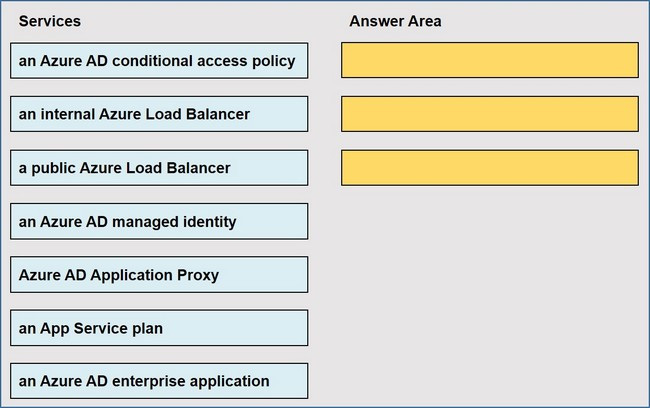
Correct Answer:
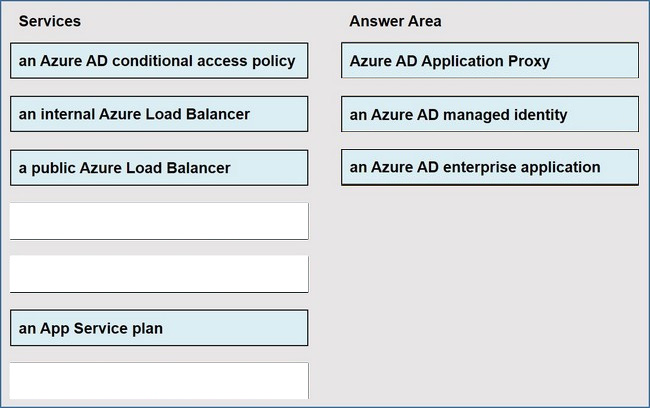
Question 11:
You are developing a sales application that will contain several Azure cloud services and will handle different components of a transaction. Different cloud services will process customer orders, billing, payment, inventory, and shipping.
You need to recommend a solution to enable the cloud services to asynchronously communicate transaction information by using REST messages.
What should you include in the recommendation?
A. Azure Service Bus
B. Azure Blob storage
C. Azure Notification Hubs
D. Azure Application Gateway
Correct Answer: A
Explanation:
Service Bus is a transactional message broker and ensures transactional integrity for all internal operations against its message stores. All transfers of messages inside of Service Bus, such as moving messages to a dead-letter queue or automatic forwarding of messages between entities, are transactional.
Reference: https://docs.microsoft.com/en-us/azure/service-bus-messaging/service-bus-transactions https://docs.microsoft.com/en-us/azure/service-bus-messaging/service-bus-messaging-overview
” Service Bus offers a reliable and secure platform for asynchronous transfer of data and state.” … “Service Bus supports standard AMQP 1.0 and HTTP/REST protocols.”
Question 12:
Your company currently has an application that is hosted on their on-premises environment. The application currently connects to two databases in the on-premises environment. The databases are named whizlabdb1 and whizlabdb2.
You have to move the databases onto Azure. The databases have to support server-side transactions across both of the databases.
Solution: You decide to deploy the databases to an Azure SQL database-managed instance.
Would this fulfill the requirement?
A. Yes
B. No
Correct Answer: A
Question 13:
You have an Azure Storage v2 account named storage1.
You plan to archive data to storage1.
You need to ensure that the archived data cannot be deleted for five years. The solution must prevent administrators from deleting the data.
What should you do?
A. You create an Azure Blob storage container, and you configure a legal hold access policy.
B. You create a file share and snapshots.
C. You create a file share, and you configure an access policy.
D. You create an Azure Blob storage container, and you configure a time-based retention policy and lock the policy.
Correct Answer: D
Explanation:
Time-based retention policy support: Users can set policies to store data for a specified interval. When a time-based retention policy is set, blobs can be created and read, but not modified or deleted. After the retention period has expired, blobs can be deleted but not overwritten.
Note:
Immutable storage for Azure Blob storage enables users to store business-critical data objects in a WORM (Write Once, Read Many) state. This state makes the data non-erasable and non-modifiable for a user- specified interval. For the
duration of the retention interval, blobs can be created and read, but cannot be modified or deleted. Immutable storage is available for general-purpose v2 and Blob storage accounts in all Azure regions.
Reference:
https://docs.microsoft.com/en-us/azure/storage/blobs/storage-blob-immutable-storage
Question 14:
Your company has an Azure Web App that runs via the Premium App Service Plan. A development team will be using the Azure Web App. You have to configure the Azure Web app so that it can fulfil the below requirements.
Provide the ability to switch the web app from the current version to a newer version Provide developers with the ability to test newer versions of the application before the switch to the newer version occurs Ensure that the application version can be rolled back Minimize downtime Which of the following can be used for this requirement?
A. Create a new App Service Plan
B. Make use of deployment slots
C. Map a custom domain
D. Backup the Azure Web App
Correct Answer: B
Question 15:
What should you include in the identity management strategy to support the planned changes?
A. Deploy domain controllers for corp.fabrikam.com to virtual networks in Azure.
B. Move all the domain controllers from corp.fabrikam.com to virtual networks in Azure.
C. Deploy a new Azure AD tenant for the authentication of new RandD projects.
D. Deploy domain controllers for the rd.fabrikam.com forest to virtual networks in Azure.
Correct Answer: A
Explanation:
Directory synchronization between Azure Active Directory (Azure AD) and corp.fabrikam.com must not be affected by a link failure between Azure and the on-premises network. (This requires domain controllers in Azure).
Users on the on-premises network must be able to authenticate to corp.fabrikam.com if an Internet link fails. (This requires domain controllers on-premises).
…
Continue learning at Leads4pass az-305 Exam resources (400 Q&A ).
Candidates can use the official website, search engines, or AI tools to help them find the preparation details before the AZ-305 exam. The most important thing is to practice the Leads4pass AZ-305 dumps in 2025: https://www.leads4pass.com/az-305.html, Make sure you pass the exam 100% successfully.